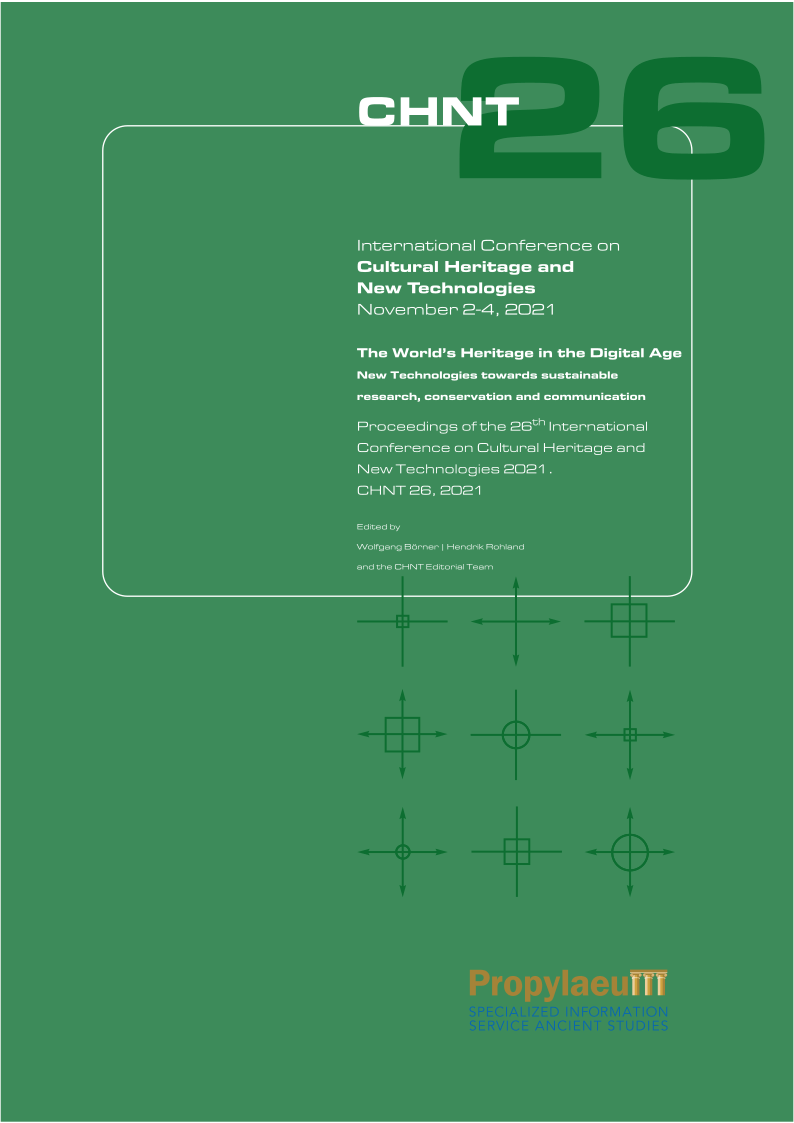Virtual reconstruction and 3D modeling for the auralization of acoustic Heritage
The case study of the Teatro del Maggio in Florence
Keywords:
Acoustic model, AURA, Mixed reality, Digital survey, Cultural heritageAbstract
The challenge of the AURA project is the creation of multisensory models performing reliably both in acoustics and in graphic rendering and virtual reality used to support and encourage business opportunities related to musical heritage and its communication and dissemination. To achieve this goal, three highly emblematic case studies at the European level will be examined to test and develop a methodology for digitization, virtual reconstruction, and auralization. The three case studies - the Konzerthaus in Berlin, the Opera in Lviv, and the Teatro del Maggio Fiorentino - have differences that influence the choice of the methodology of analysis and the technical tools to be applied. The solution presented in this paper for the case study of the Teatro del Maggio in Florence foresees not only to develop multisensory 3D models based on reliable metric-morphological supports but also to create a scientific and replicable methodology of the workflow of the elements classification and virtual reconstruction aimed at auralization.
References
Bartalucci, C., Borchi, F., Carfagni, M., Luzzi, S. and Busa, L. (2018). ‘The Acoustic Design and Requalification of an Audito-rium in a Church and of a Historical Theater’, IOP Conference Series: Materials Science and Engineering, 364, pp. 1-8.
Bertocci, S., Lang, F., Sauter, C., Sieck, J. and Shakhovska, N. (2021). ‘Il progetto AURA: proposta di auralizzazione di al-cuni teatri europei per la creazione di paesaggi sonori virtuali’, Paesaggio Urbano – Urban Design, 2 (2), pp. 84-89.
Böhm, C., Ackermann, D. and Weinzierl, S. (2018). ‘A multi-channel anechoic orchestra recording of Beethoven's Sympho-ny No. 8 op. 93’, Journal of Audio Engineering Society, 68 (12), pp. 977-984.
Bortolotto, C. (2008). Il patrimonio immateriale secondo l’UNESCO. Analisi e prospettive. Roma: Istituto Poligrafico e Zecca dello Stato.
Calcagno, E., Abregù, E., Eguia, M. and Vergara, R. (2012). ‘The role of vision in auditory distance perception’, Perception, volume 41, pages 175-192.
Cioli, F. (2020). ‘Il patrimonio culturale immateriale: Un dialogo tra oriente e occidente/The intangible cultural heritage: A dia-logue between East and West’, Firenze Architettura, Oriente - Occidente rilievi, Quaderni 2020, pp. 114-119.
Cioli, F. and Ricci, Y. (2020). ‘L’Officina Profumo-Farmaceutica di Santa Maria Novella. From the Point Cloud to the Virtual Reality’, Proceedings of UID 2020 - Connettere. Un disegno per annodare e tessere. 42° Convegno Internazionale dei docenti delle discipline della Rappresentazione, Milano: FrancoAngeli, pp. 1958-1973.
Droste, M., Letellier, J., Böhm, C. and Resch, T. (2020). ‘Combining high-fidelity visuals and spatial acoustics in virtual reali-ty. Auralization of a virtual string quartet’, Proceedings of KUI 2020 - Kultur und Informatik: Extended Reality, Glückstadt: Verlag Werner Hülsbusch, pp. 179-192.
Gasparini, L. (2014). Il patrimonio culturale immateriale. Riflessioni per un rinnovamento della teoria e della pratica sui beni culturali. Milano: Vita e Pensiero.
Katz, B., Murphy, D. and Farina, A. (2020a). ‘The Past Has Ears (PHE): XR Explorations of Acoustic Spaces as Cultural Heritage’, International Conference on Augmented Reality, Virtual Reality and Computer Graphics AVR 2020, Springer Professional. pp. 91-98.
Katz, B., Murphy, D. and Farina, A. (2020b). ‘Simulating the acoustics of destroyed or altered amphitheatres, cathedrals, and other architectural sites re-creates their sonic grandeur’, Physics Today, 73 (12), pp. 32-37.
Katz, B., Poirier-Quinot, D. and N. J. Postma, B. (2019). ‘Virtual reconstructions of the Théâtre de l’Athénée for archeo-acoustic study’, Proceedings of ICA 2019 - 23rd International Congress on Acoustics in Aachen (Germany), Red Hook (NY-USA): Curran Associates, Inc, pp. 302-310.
Kleiner, M., Dalenbäck, B. and Svensson, P. (1993). ‘Auralization - An overview,’ Journal of the Audio Engineering Society, 11 (41), pp. 861–875.
McLellan, H. (2004). ‘Virtual Realities’, in D. Jonassen, M. Driscoll (Eds.), Handbook of Research on Educational Communi-cations and Technology. New York: Routledge, pp. 461-498.
Mures, O. A., Jaspe, A., Padrón, E. J. and Rabuñal, J. R. (2016). ‘Virtual Reality and Point-Based Rendering in Architecture and Heritage’, in G. Amoruso (Ed.), Handbook of Research on Visual Computing and Emerging Geometrical Design Tools. IGI Global, pp. 78-95.
Pompoli, R. and Prodi, N. (2000). ‘Guidelines for acoustical measurements inside historical opera houses: procedures and validation’, Journal of Sound and Vibration, 232 (1), pp. 281-301.
Reinhold, J. and Conta, S. (2012). ‘L’acustica del nuovo teatro dell’opera di Firenze: scelte innovative in un teatro (quasi) classico’, Proceedings of AIA 2012 - 39° Convegno Nazionale dell'Associazione Italiana di Acustica, Roma, pp. 1-6.
Rindel, J. G. (2011). ‘The Erato project and its contribution to our understanding of the acoustics of ancient theatres’, Pro-ceedings of The Acoustics of Ancient Theatres Conference, Patras, pp. 1-6.
Weinzierl, S. and Lepa, S. (2019). ‘On the Potential of Virtual Realities for the Sciences. A Methodological Framework’, in Ariso, M. J. (Ed.), Augmented Reality. Reflections on Its Contribution to Knowledge Formation. Berlin / Boston: De Gruy-ter, pp. 61-80.
Downloads
Published
Conference Proceedings Volume
Section
License
Copyright (c) 2023 Stefano Bertocci, Andrea Lumini, Federico Cioli

This work is licensed under a Creative Commons Attribution-NonCommercial-NoDerivatives 4.0 International License.
The CHNT older Proceedings are licensed under the creative commons license CC BY-NC-ND 3.0.
From the issue 26 on, they will be licensed under the creative commons license CC-BY-SA 4.0


